The best plants for a fence line. Planting along the fence line can add a visual appeal to a fence other than its main practical function.
They can often help enhance the fence’s beauty and change the complete outlook of the outdoor area of a house.
Listed further down are some of the best plants that can be used to cover a fence line.
30 Best Plants for Fence Line
- Clematis
- Ivy
- Honeysuckle
- Morning Glory
- Climbing Roses
- Lilly Pilly
- Hydrangeas
- Cherry Laurel
- Photinia
- Verbena Bonariensis
- Stipa Tenuissima
- Libertia Chilensis
- Japanese Anemones
- Curtain Creeper
- Chilean Potato Bush
- Garlic Creeper
- Rangoon Creeper
- The Arctic Kiwi
- Crimson Glory Vine
- Trailing Abutilon
- Jasmine
- Coral Pea
- Chinese Wisteria
- Bougainvillea
- Crossvine
- Trumpet Vine
- Hyacinth Bean
- Hops
- Mandevilla
- Moonflower Vine
Related: Best Plants for Privacy in the Garden

30 Best Plants for Fence Line
30 Plants for Fence Line – Best in 2023
1. Clematis
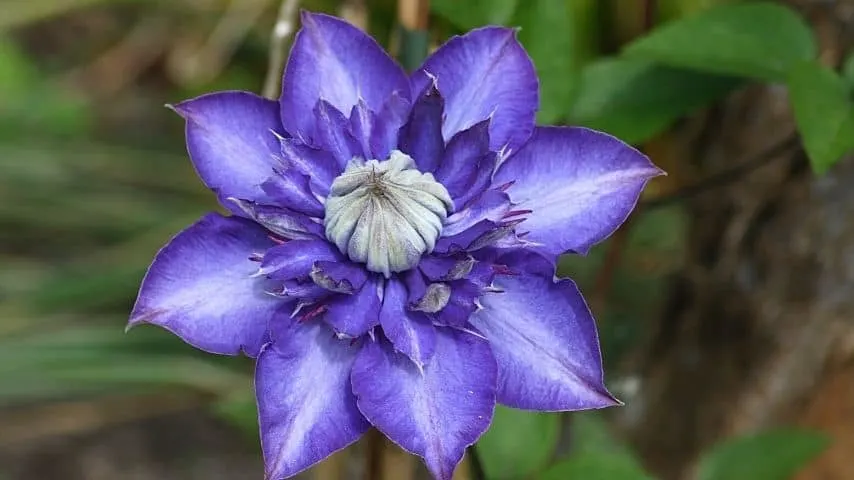
Clematis are part of climbing plants that you can grow on your fence line
Clematis are part of climbers that can easily grow along a fence line, but they need wires to cling to.
They are best to grow over a fence line because their roots are like shade, and the foliage remains even when the flowers are gone in the fall season.
- Scientific name: Clematis
- Family: Ranunculales
- Temperature: Night temperature should be less than 45°F (7°C). Colder temperature leads to dormancy.
- Fertilizer: low nitrogen fertilizer in spring followed by alternate feedings every 4 to 6 weeks until the end of the season.
- pH: 6.5 to 7.0
- Soil: moisture-retentive soil
- Lighting: At least 6 hours of sun each day for ideal bloom. Some can grow in the shade as well.
- Growth rate: This can vary from growing a few feet each year to over 20 feet in one year.
- Humidity: 60% to 80%
2. Ivy
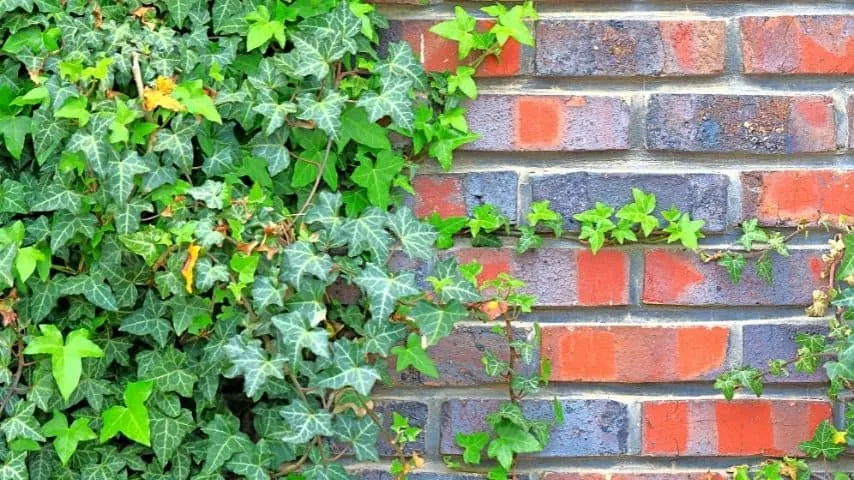
Ivy doesn’t need support when you grow it for your fence line
Ivy has flowers and berries, making it a good option for all seasons. Apart from that, it also provides complete foliage for fences that require privacy.
Climbing Ivy does not need support to cover the fence.
- Scientific name: Hedera
- Family: Araliaceae
- Temperature: 65 to 85°F (18 to 29°C)
- Fertilizer: Houseplant fertilizer is diluted to half strength during summer and spring once monthly
- pH: 5.5 to 6.5
- Soil: Well-drained soil. It can also grow in poor soils, but its quality is compromised.
- Lighting: bright to medium light.
- Growth rate: 8 to 9 feet a year. It takes three years to develop.
- Humidity: 40% or higher.
3. Honeysuckle
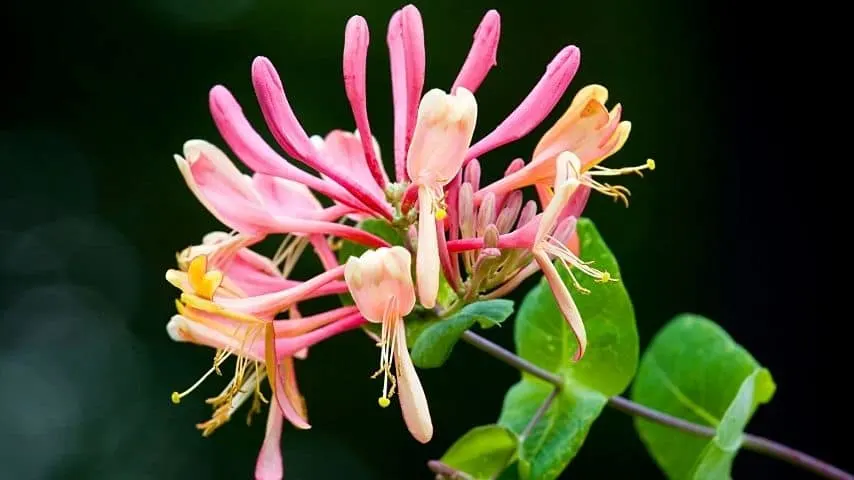
Honeysuckle might need some support when you grow it for your fence line due to their thin stems
Honeysuckle, a native to Asia, according to the University of Washington can be a beautiful addition to a fence because it adds up to the colors of the landscaping because of its flowers and shiny red berries from mid-summer to autumn.
However, it might need some support to climb the fence because of its thin stems.
- Scientific name: Lonicera periclymenum
- Family: Caprifoliaceae
- Temperature: Most can withstand cool weather, but some might require additional winter care.
- Fertilizer: All-purpose fertilizer once or twice a year in spring, around February.
- pH: 5.5 to 8.0
- Soil: Moist yet not soggy soil; best to use organically rich and well-draining soils
- Lighting: Full sun is best but it can also grow in shaded areas.
- Growth rate: 9 to 12 feet per year
- Humidity: 60% to 80%
4. Morning Glory
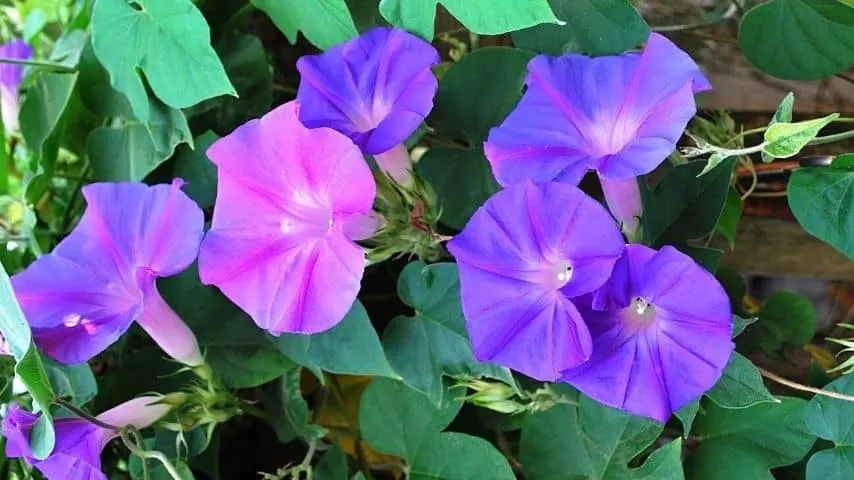
Morning Glory, with its beautiful blue, heart-shaped flowers, is a great plant to cover your fence lines
Morning glory is a fast-growing plant best for covering fence lines because of its attractive heart-shaped blue flowers that blossom in the morning and close in the afternoon.
- Scientific name: Ipomoea
- Family: Convolvulaceae
- Temperature: 70 to 85°F (21 to 30°C)
- Fertilizer: All-purpose flowers monthly during the growing season for best results.
- pH: 6.0 to 6.8
- Soil: Moist but well-draining. Not too rich in organic matter.
- Lighting: Full sun is required.
- Growth rate: Up to 12 feet or more in one season.
- Humidity: No special humidity needs.
5. Climbing Roses
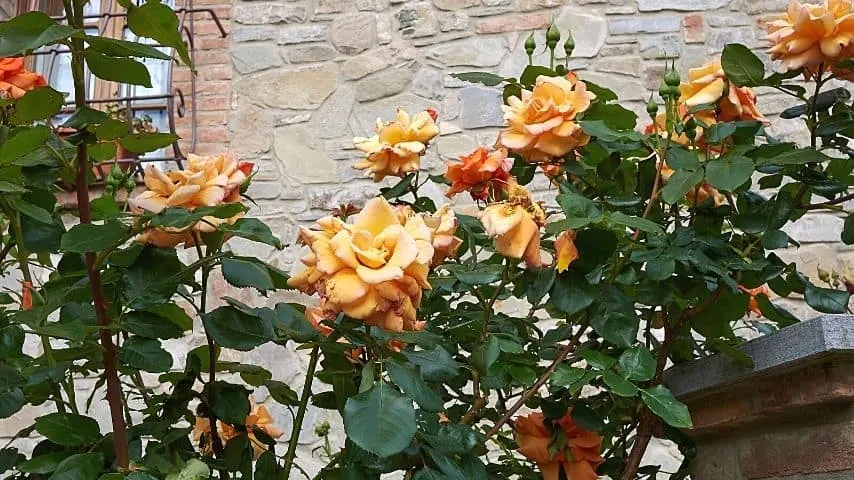
Climbing Roses, with its fast-growing and colorful varieties, are great additions in covering your fence lines
Climbing roses are a very beautiful addition to a fence line.
Depending on different types of climbing roses, there are fast-growing and colorful varieties. They do need adequate support for their canes.
- Scientific name: Rosa spp.
- Family: Rosaceae
- Temperature: cannot withstand temperatures below 32°F (0°C).
- Fertilizer: Organic fertilizer with nitrogen-phosphorus-potassium.
- pH: Near 6.5
- Soil: Slightly acidic, well-drained soil.
- Lighting: Location with full sun, but can also tolerate light shade.
- Growth rate: 2 to 3 years to become fully established and reach full height.
- Humidity: 60% to 70%
6. Lilly Pilly
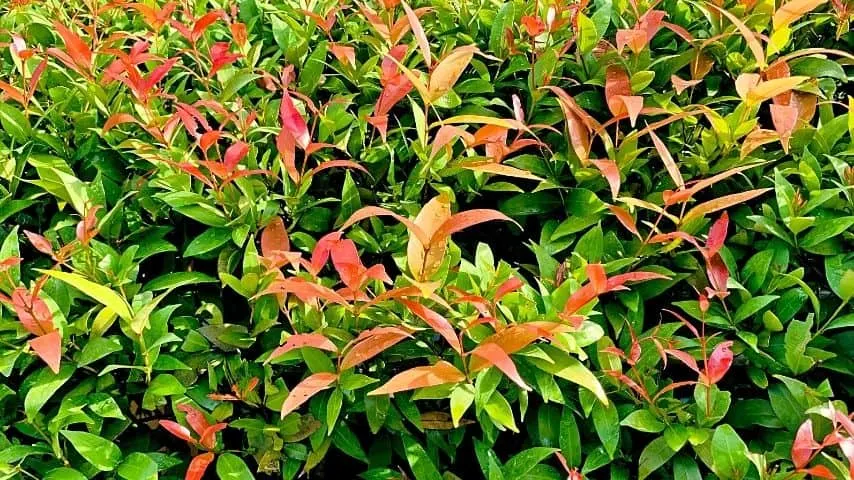
Lilly Pilly’s dark green foliage with pink tips is another beautiful plant to cover fence lines
It is a shrub plant for fence lines, also known as the ‘Australian Cherry’, that provides thick, dense, dark green foliage with pink tips.
It is present around the year and is resistant to many climatic and soil changes.
- Scientific name: Syzygium smithii
- Family: Myrtaceae
- Temperature: Requires warm weather and can tolerate frosts and coastal conditions.
- Fertilizer: Manure, compost, or a certified organic pelletized fertilizer in spring, summer, and autumn.
- pH: Neutral
- Soil: Good, fertile, and moist soil. It cannot tolerate wet areas, so proper drainage is required.
- Lighting: Full sun to partly shaded position in the garden.
- Growth rate: 6 feet a year.
- Humidity: No special humidity needs, but it can attract pests in too much humidity.
7. Hydrangeas
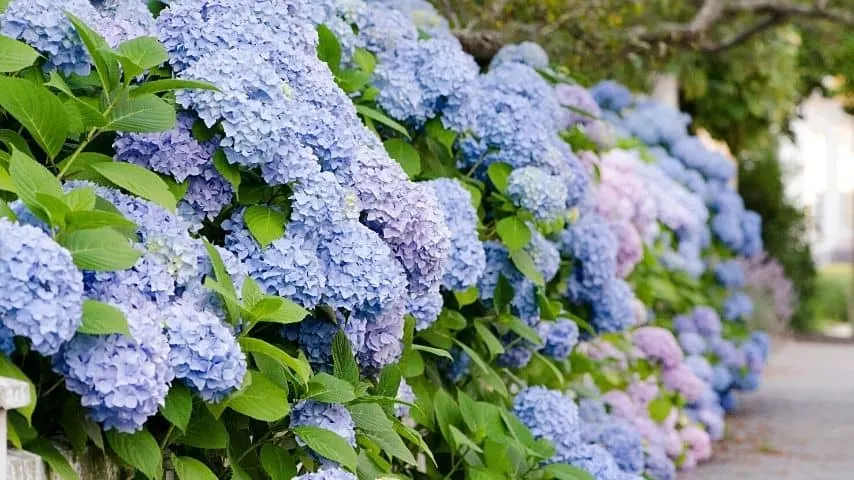
Hydrangeas have adorable pom-pom-shaped blossoms that can beautify your fence lines
Hydrangeas are another type of fence line plant in the shrub category. Hydrangeas have a strong leaf shape and pom-pom heads that give a very stylish touch to the fence line.
They’re usually used for decorative purposes rather than coverage.
- Scientific name: Hydrangea macrophylla
- Family: Hydrangeaceae
- Temperature: Can sustain temperatures up to 14°F (-10°C)
- Fertilizer: An all-purpose fertilizer used in March, May, and July.
- pH: About 6.0 to 6.2
- Soil: Friable, loam soil and soil with high organic content. It should be able to hold moisture
- Lighting: Six hours of direct sunlight at a minimum
- Growth rate: 2 feet or more per year
- Humidity: average to high humidity
8. Cherry Laurel
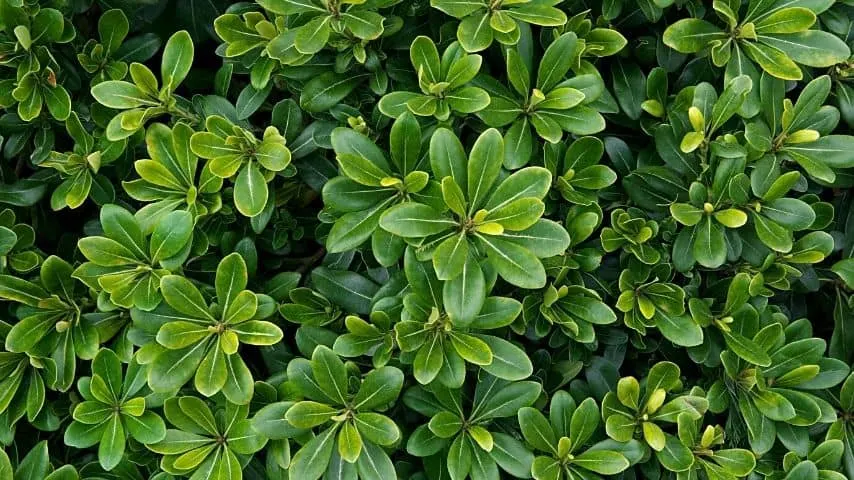
If you’re looking for a reliable yet easy-to-take-care of plant to cover your fence line, the Cherry Laurel is a great choic
Cherry Laurel is a reliable plant that is easy to care for and provides a good backdrop for your fence.
It mainly comprises thick, dense leaves that may need trimming once a year if you prefer a more refined look. It’s also a part of the shrub category.
- Scientific name: Prunus laurocerasus
- Family: Rosaceae
- Temperature: 59°F to 68°F (15-20°C)
- Fertilizer: organic (slow-acting), calibrated (promotes drought resistance and winter hardiness) fertilizer applied at least once a year.
- pH: 6.5 to 7.5
- Soil: fertile and well-drained soil.
- Lighting: Partial to full sun; can also thrive in full shade
- Growth rate: Around 0.9-2 feet per year.
- Humidity: 40% or higher.
9. Photinia
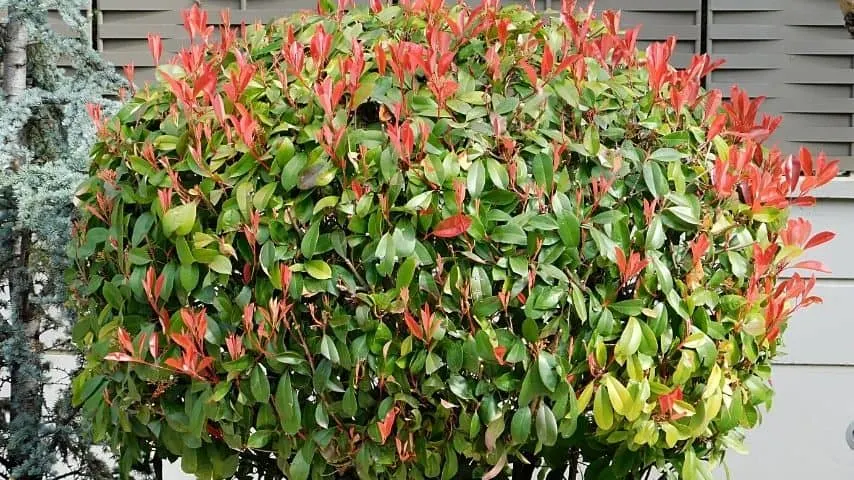
Photinia’s vibrant red leaves are another great way to spruce up your fence lines
Photinia is an evergreen plant with vibrant red leaves that adds much more to the beauty and foliage.
- Scientific name: Photinia serratifolia
- Family: Rosaceae
- Temperature: Can tolerate temperature down to 5°F (-15°C)
- Fertilizer: 12-month controlled-release fertilizer at the start of spring.
- pH: 6.0 to 7.5
- Soil: Fertile, well-draining soil that’s humus-rich and moist
- Lighting: Full sun or partial shade.
- Growth rate: 1 to 3 feet per year.
- Humidity: does not do well in very wet and humid environments.
10. Verbena Bonariensis
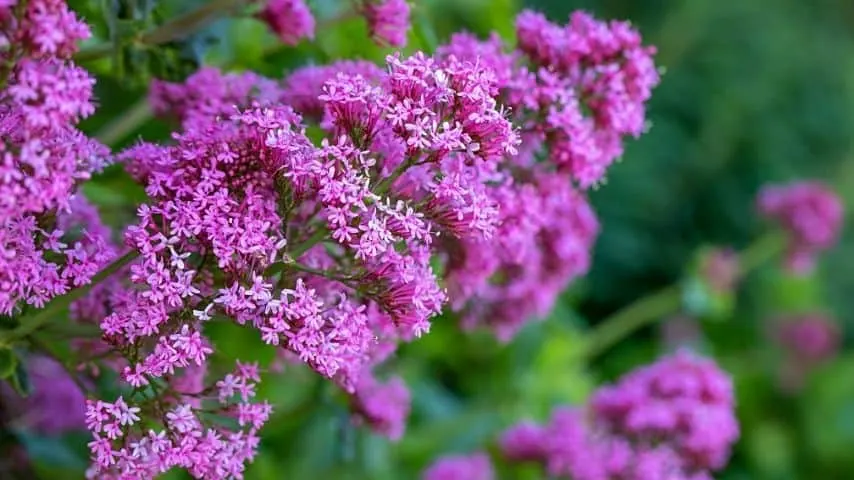
Verbena bonariensis grows upwards. Hence, it’s a great cover for your fence lines
It is an elegant and simple plant with small purple flowers on thin stems. The plant grows upwards, not outwards, and provides a stylish, see-through screen for the fence.
- Scientific name: Verbena bonariensis
- Family: Verbenaceae
- Temperature: 68-77°F (20-25°C)
- Fertilizer: balanced flower fertilizer that’s s slow-releasing once monthly
- pH: 5.8 to 7.2
- Soil: well-drained soil.
- Lighting: full sun throughout the day.
- Growth rate: 5 feet per season.
- Humidity: Don’t fare well in humid and hot climates
11. Stipa Tenuissima
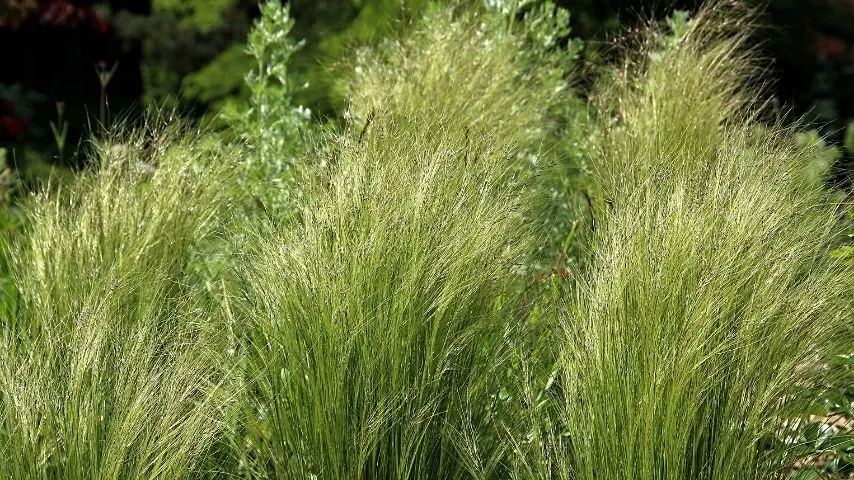
Stipa Tenuissima has long grass structures that are effective to act as screen for your fence lines
They are effective for screening with long grass structures and fluffy panicles of gold and silver flowers on thin stems. The stems are upright, not very tall, but wide.
- Scientific name: Nassella tenuissima
- Family: Poaceae
- Temperature: Withstand temperatures as low as 15°F (-10°C)
- Fertilizer: Fertilize before winter, moderately decomposed compost or manure.
- pH: 6.0 to 7.0
- Soil: Well-drained soil
- Lighting: 16 hours of continuous lighting.
- Growth rate: 2 feet per season.
- Humidity: Intolerant of high humidity and short-lived in humid environments.
12. Libertia Chilensis
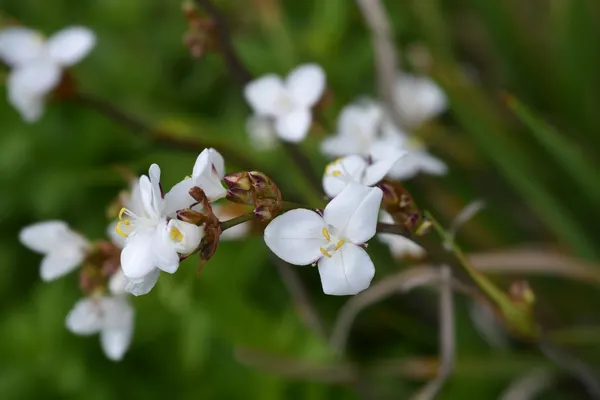
New Zealand Satin Flower
New Zealand Satin Flower or Libertia formosa is an evergreen perennial with the top covered with small white daisy-like flowers. The stem is stiff with clustered upright leaves.
Its binomial nomenclature and basic plant care requirements include:
- Scientific name: Libertia formosa
- Family: Iridaceae
- Temperature: Above 41°F (5°C)
- Fertilizer: NPK balanced feeding during crop time
- pH: 5.0 to 5.5
- Soil: Well-drained soil
- Lighting: Full sun or partial shade with free draining.
- Growth rate: 3 feet high and 4 feet wide after 5-6 years
- Humidity: can survive in humid and hot climates
13. Japanese Anemones
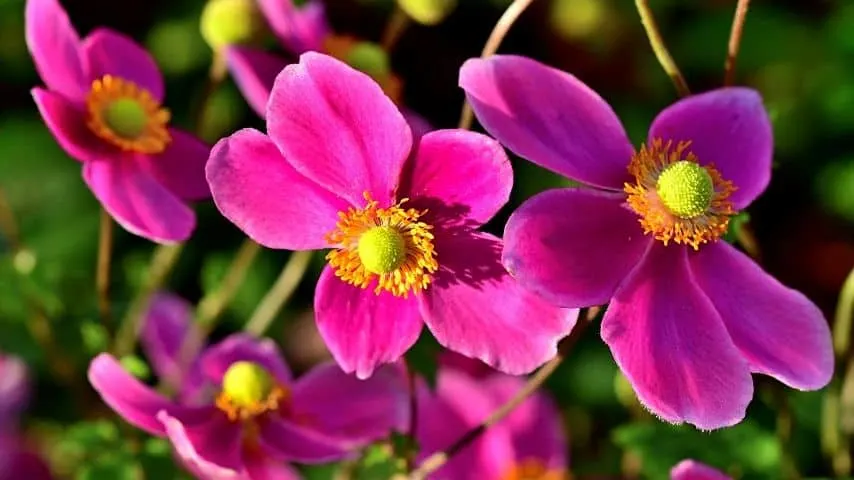
Japanese Anemones have beautiful flowers that can help beautify your fence line
Japanese anemones are pretty, small flowers with upright stems, and the flowers appear to be as if they are floating above the foliage.
They give the fence line a summer/autumn color and a beautiful structure.
- Scientific name: Anemone hupehensis
- Family: Ranunculaceae
- Temperature: Above 40°F (4°C)
- Fertilizer: Twice a year with slow-release chemical fertilizer or organic fertilizer.
- pH: 5.8 to 6.2
- Soil: rich, humus-rich, evenly moist, well-drained soils
- Lighting: Partial shade is best. Full sun will dry out the oil, and full shade affects flowering.
- Growth rate: 1 to 2 years to establish. After that, they grow faster and form colonies.
- Humidity: Low
14. Curtain Creeper
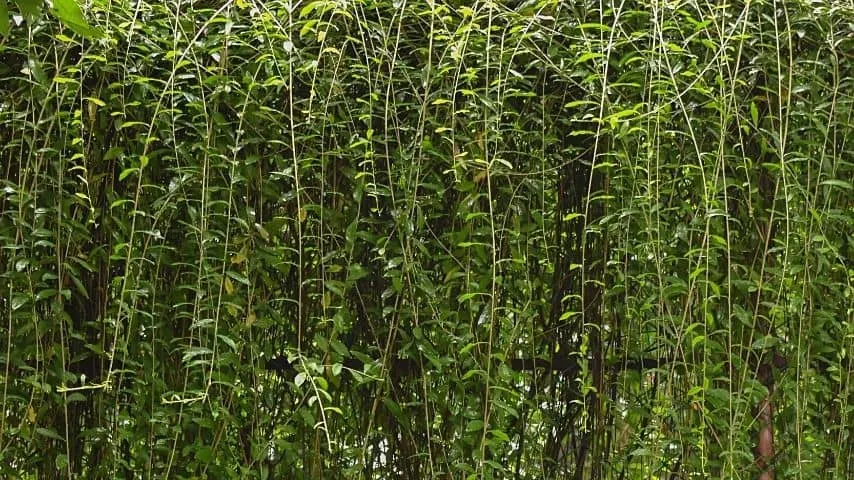
Curtain Creeper is another beautiful plant you can grow to beautify your fence line
Curtain creeper is a vine that can fall beautifully over the fence line and add to its beauty.
- Scientific name: Vernonia Elaeagnifolia
- Family: Asteraceae
- Temperature: Up to 93°F (34°C)
- Fertilizer: Any organic fertilizer.
- pH: 6.0 to 8.0
- Soil: evenly moist, rich, well-drained soil
- Lighting: Full sun
- Growth rate: Can grow up to a height of 15 feet.
- Humidity: No special humidity requirements.
15. Chilean Potato Bush
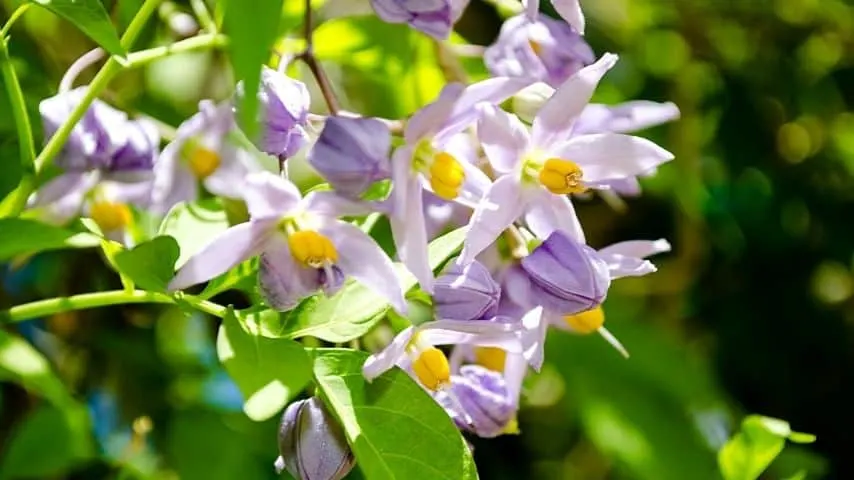
Chilean Potato Bush is a free-standing shrub that you can grow near your fence line
It is a hardy, evergreen free-standing shrub grown against a wall or fence. It forms clusters of blue, fragrant flowers, adding to the fence’s visual appeal.
- Scientific name: Solanum crispum
- Family: Solanaceae
- Temperature: can tolerate as low as 5°F (-15°C)
- Fertilizer: 2 inches compost layer once or twice a year; a balanced, slow-releasing, and complete fertilizer in late summer or spring; or a liquid fertilizer once in a month or 2 months
- pH: 7.0 to 8.5
- Soil: fertile, moist, neutral to slightly alkaline but well-drained soil.
- Lighting: Full sun
- Growth rate: Fast-growing
- Humidity: Can tolerate hot and humid climates.
16. Garlic Creeper
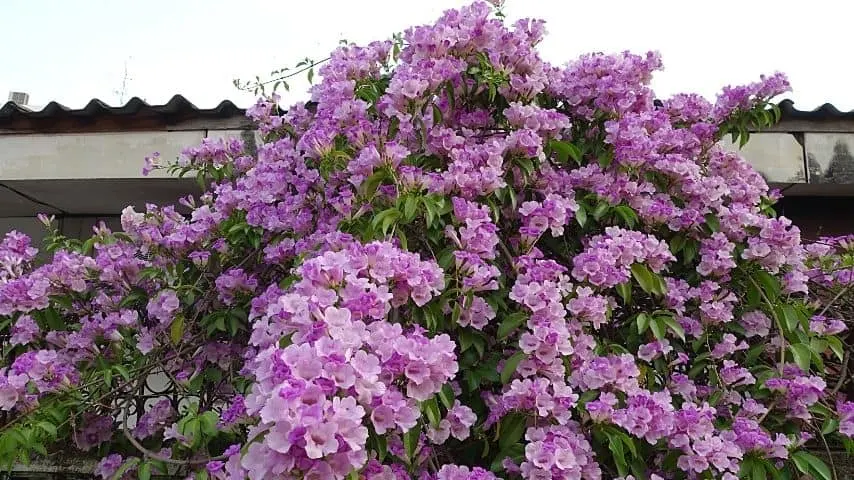
Garlic Creeper is another flowering plant you can grow to cover your fence line
Garlic creeper is an ornamental vine with leaves divided into opposite sides and flowers. These are best for beautifying a fence line and the overall landscaping of the outdoor space.
- Scientific name: Mansoa alliacea
- Family: Bignoniaceae
- Temperature: 77 to 95 °F (25 to 35°C)
- Fertilizer: Any organic fertilizer once a month.
- pH: 5.0 to 6.5
- Soil: Rich in organic content, fertile and well-draining
- Lighting: Natural direct 3-6 hours of morning sunlight and natural indirect bright light during the remaining hours of the day
- Growth rate: Moderate growth rate.
- Humidity: Requires moderate humidity.
17. Rangoon Creeper
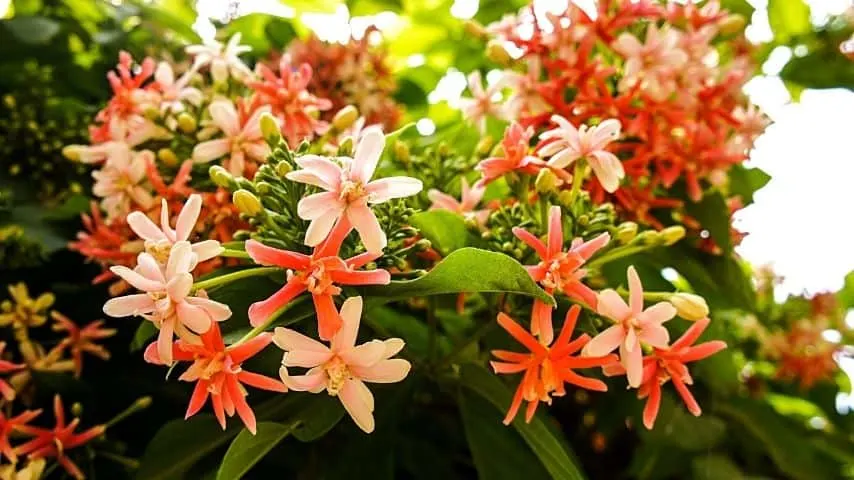
Rangoon Creeper is a subtropical vine that can beautify your fence line
Rangoon creeper is a sub-tropical vine with red flower clusters that can grow up to 8 meters and drape over a fence. These are best to cover fence lines to increase the overall beauty of the outdoor space.
- Scientific name: Combretum indicum
- Family: Combretaceae
- Temperature: Tolerates high temperatures but does not do well in low temperatures,
- Fertilizer: Composted cow manure or granular fertilizer twice a year.
- pH: 5.5 to 6.5
- Soil: Well-draining
- Lighting: Both full sun and part shade.
- Growth rate: 2 to 5 feet in one season.
- Humidity: requires a humid climate.
18. The Arctic Kiwi
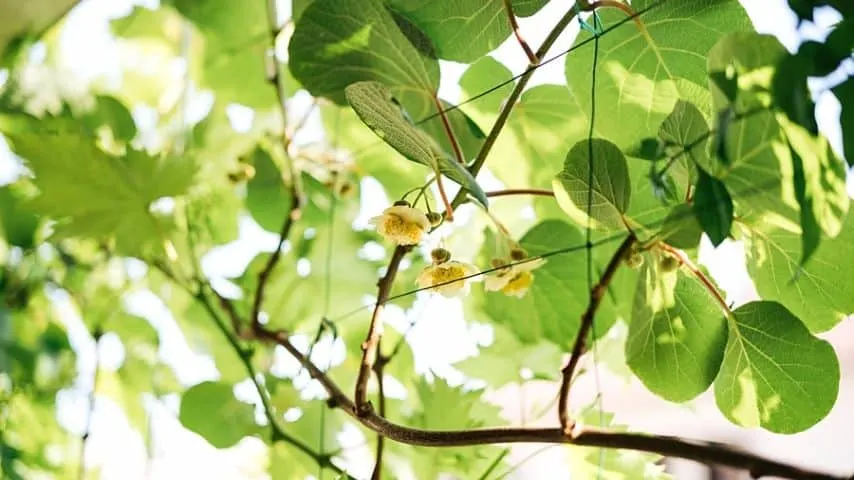
The Arctic Kiwi is another flowering plant that you can cover your fence line with
The arctic kiwi is a flowering one that can easily climb any fence or wall and give it striking foliage.
Apart from its small pink and white leaves, it also produces fruit, making it even more helpful to plant outside a house.
- Scientific name: Actinidia kolomikta
- Family: Actinidiaceae
- Temperature: Temperatures as low as -30°F (-34°C).
- Fertilizer: Fertilizer that has phosphorus, P, in it during the first growing season or at the time of planting
- pH: 5.0 to 6.5
- Soil: Moist but well-drained.
- Lighting: Can tolerate a range of sun to shade but blooms best in high sun exposure.
- Growth rate: 5 to 10 years to reach full height potential.
- Humidity: can survive hot and humid climates but not frosts.
19. Crimson Glory Vine
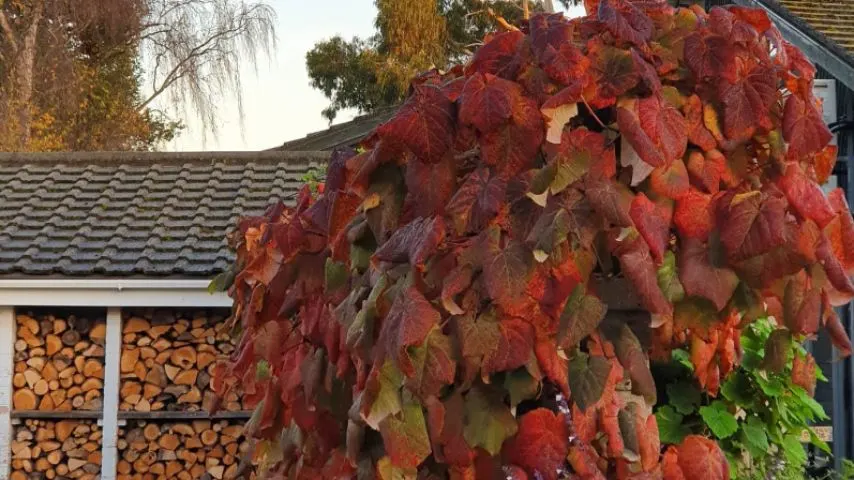
Photo Credit: @bethchattogardens on Instagram!
It is a vigorous and strong growing climbing vine known for its impressively decorative foliage. Its big heart-shaped leaves give dense foliage to the fence.
The leaves remain dark green throughout the summer and turn to vibrant red, purple, and scarlet shades in autumn, adding to the beautification.
- Scientific name: Vitis coignetiae
- Family: Vitaceae
- Temperature: Can tolerate temperatures as low as -20°C (-28°C) but not lower.
- Fertilizer: complete fertilization each spring
- pH: neutral to slightly alkaline.
- Soil: fertile, well-drained, chalky soil
- Lighting: full sun, partial sun.
- Growth rate: Hanging/cascading growth of 49 feet or more in height with annual shoot growth of 6-16 feet
- Humidity: dry, mean, humid.
20. Trailing Abutilon
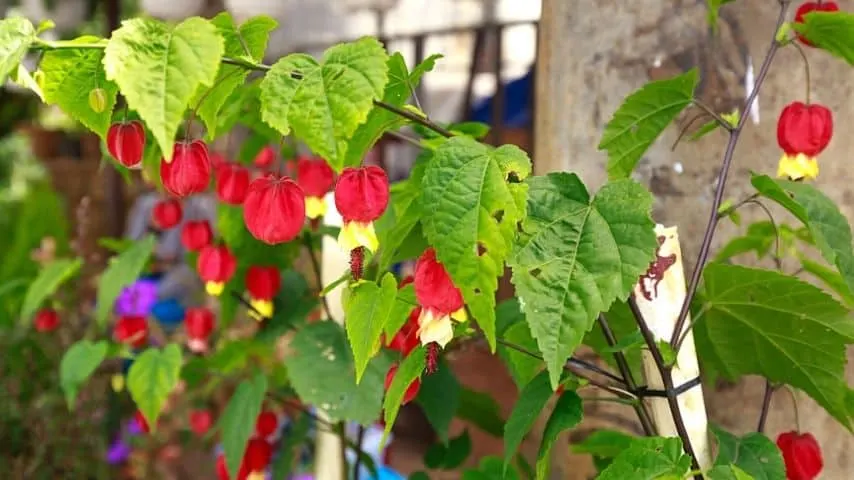
Trailing Abutilon is another beautiful plant that adds visual appeal to your fence line
Trailing abutilon is an evergreen shrub with bell-shaped orange and yellow flowers with a red base. It is perfect for a fence line to increase the outdoor space’s visual appeal
- Scientific name: Abutilon megapotamicum
- Family: Malvaceae
- Temperature: 60°F (14°C) and above
- Fertilizer: Fertilizer with phosphorus, P, during the first growing season.
- pH: Acid to neutral
- Soil: Well-draining and moist soil of any type
- Lighting: In the morning, full sun; in the hot afternoon, some shade
- Growth rate: Up to 4 feet tall in a single season.
- Humidity: can get attacked by aphids and mites if humidity is insufficient.
21. Jasmine
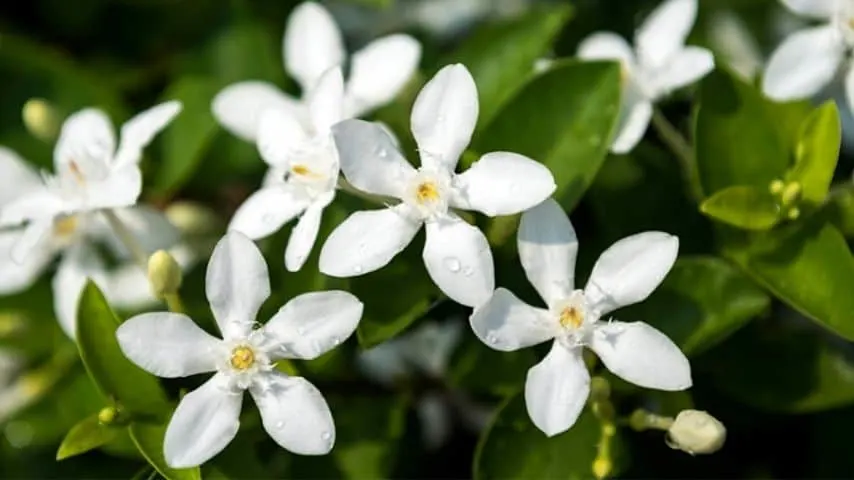
Jasmine, with its white star-shaped blooms, is another gorgeous plant to cover your fence line
Jasmine is a genus of shrubs and vines with clusters of starry, pure white flowers that bloom all summer. Jasmine is known for its fragrance and overall beauty, which helps add a pretty touch to the fence line.
- Scientific name: Jasminum
- Family: Oleaceae
- Temperature: Between 60 to 70°F (14-21 °C).
- Fertilizer: A 7-9-5 fertilizer in late winter or spring if you’re in an area with mild climate
- pH: Between 4.9 and 8.3
- Soil: Moist and well-draining yet moderately fertile loamy, sandy soil.
- Lighting: Bright but indirect sunlight
- Growth rate: 1-2 feet a year
- Humidity: 40-50% relative humidity
22. Coral Pea
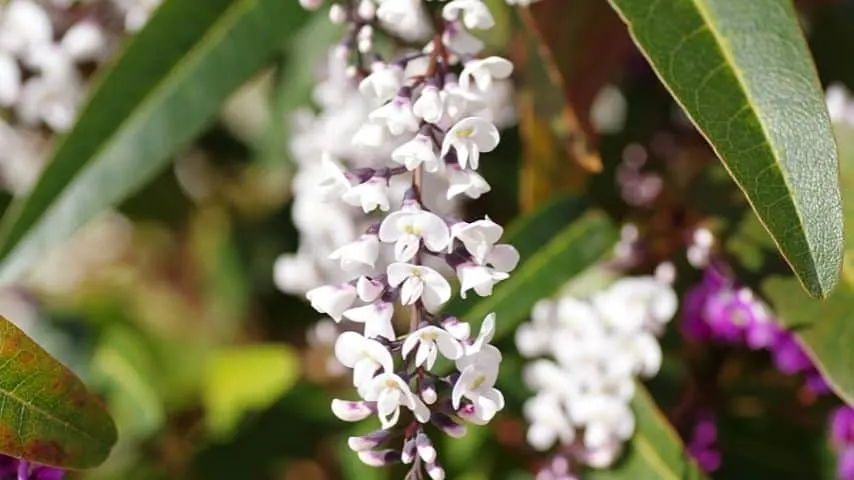
The evergreen dark purple blooms of the Coral Pea is enough to liven up your fence line
Coral pea is a mass of climbing, evergreen dark purple flowering plants with dark green leaves.
- Scientific name: Hardenbergia violacea
- Family: Fabaceae
- Temperature: cannot withstand temperature below 24°F (-3°C).
- Fertilizer: Light applications of ammonium phosphate fertilizer once or twice a year.
- pH: 5.5 to 6.0.
- Soil: well-drained soil.
- Lighting: Sunny to semi-shaded positions.
- Growth rate: Grows up to 6 feet at a fast pace.
- Humidity: Moderate humidity
23. Chinese Wisteria
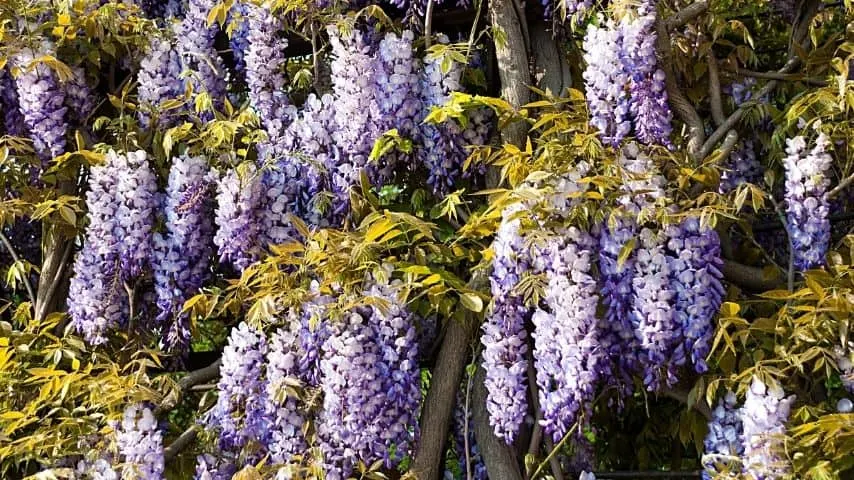
Chinese Wisteria, with its twining and flowering vines, is enough to beautify your fence line
Chinese Wisteria is flowering twining vines that climb up fences, walls, and tree trunks.
- Scientific name: Wisteria Sinensis
- Family: Fabaceae
- Temperature: Can withstand temperatures as cold as -20°F (-28°C), but prolonged cold affects flowering.
- Fertilizer: Low-nitrogen product once every year.
- pH: 6.0–7.0
- Soil: humus-rich, slightly acidic, and moderately fertile soil
- Lighting: Partial to full sun.
- Growth rate: 10 feet a year
- Humidity: Can grow in dry climates if the soil remains moist despite thriving in high-humidity areas
24. Bougainvillea
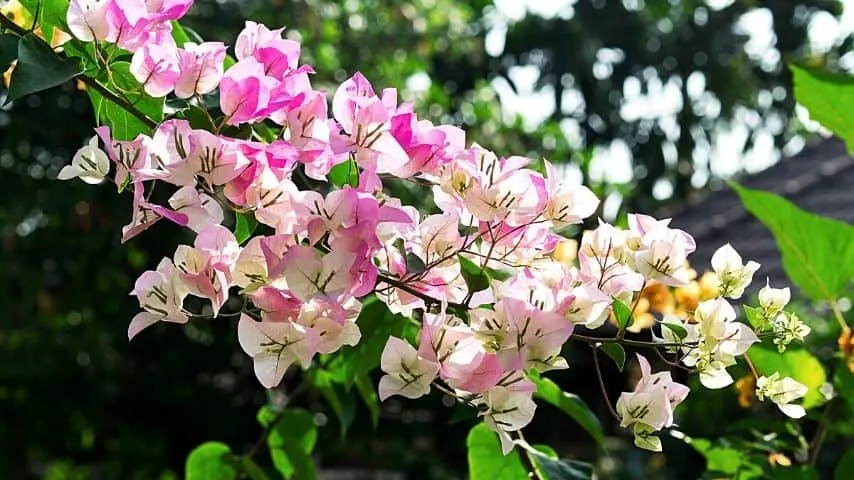
Bougainvillea, whether as a vine or a bush, can spruce up your fence line
Bougainvillea is vibrant, blooming vines and bushes in various colors that can decorate any fence line.
- Scientific name: Bougainvillea
- Family: Nyctaginaceae
- Temperature: Around 60 to 70°F (14-21 °C)
- Fertilizer: Slow-releasing yet balanced fertilizer containing potassium, nitrogen, and phosphorus in equal ratios
- pH: 5.5–6.0
- Soil: Peat moss-scarce and well-draining potting soil
- Lighting: Full sun for a minimum of 6 hours daily
- Growth rate: 3 feet a year or more
- Humidity: Likes high humidity.
25. Crossvine
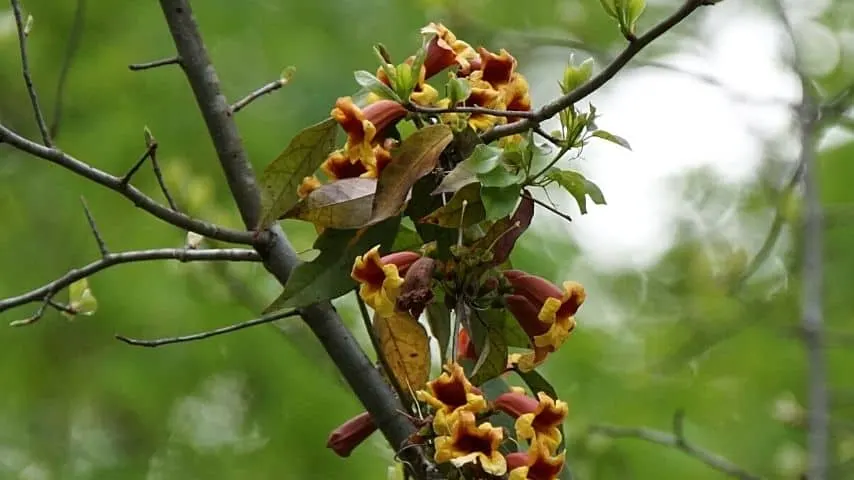
Another colorful plant that can cling to your fence line without support is the Crossvine
It is a climbing woody vine with long showy, red-orange flowers, often together in a cluster of 4 or 5. They can cling to the fence line without support.
- Scientific name: Bignonia capreolata
- Family: Bignoniaceae
- Temperature: grows in hot temperatures and has good cold tolerance.
- Fertilizer: organic NPK 8-5-5 fertilizer early in spring before it flowers and after the blooms fade.
- pH: 6.8 to 7.2
- Soil: Well-drained soil. An ideal soil is loamy, and sandy with good organic matter.
- Lighting: Grows best in full sun but will tolerate some shade.
- Growth rate: Fast
- Humidity: no special humidity requirements.
26. Trumpet Vine
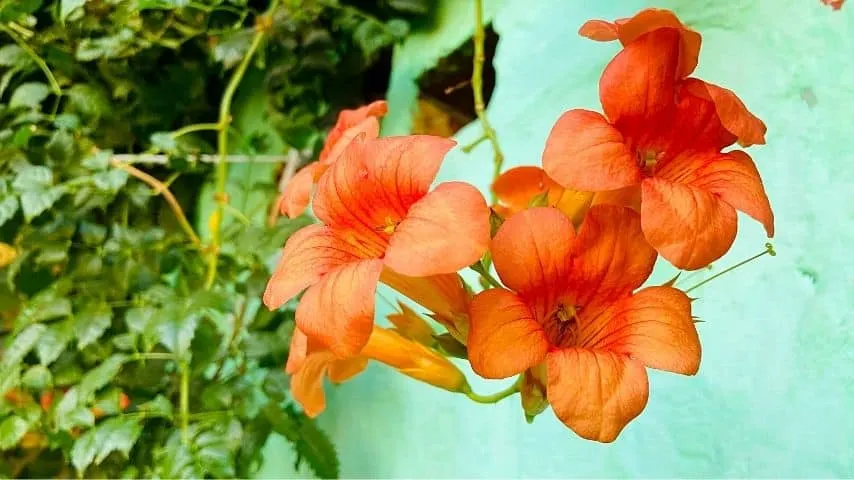
Trumpet Vine is a tubular-shaped vine that beautifies your fence line with its vibrant blooms
The trumpet vine is a beautiful tubular-shaped vine in yellow, orange, and red colors.
- Scientific name: Campsis radicans
- Family: Bignoniaceae
- Temperature: It is a summer plant but is usually strong enough to endure winter.
- Fertilizer: 30 ml or 2 tablespoons of fertilizer with a 10-10-10 ratio around the vine’s root area
- pH: between 3.7 and 6.8
- Soil: dry to wet soils and clay, loamy, and sandy soil types
- Lighting: full sun to partial shade.
- Growth rate: Needs six months to grow to its mature size
- Humidity: the natural range is a hot and humid climate. Less humidity leads to less growth rate.
27. Hyacinth Bean
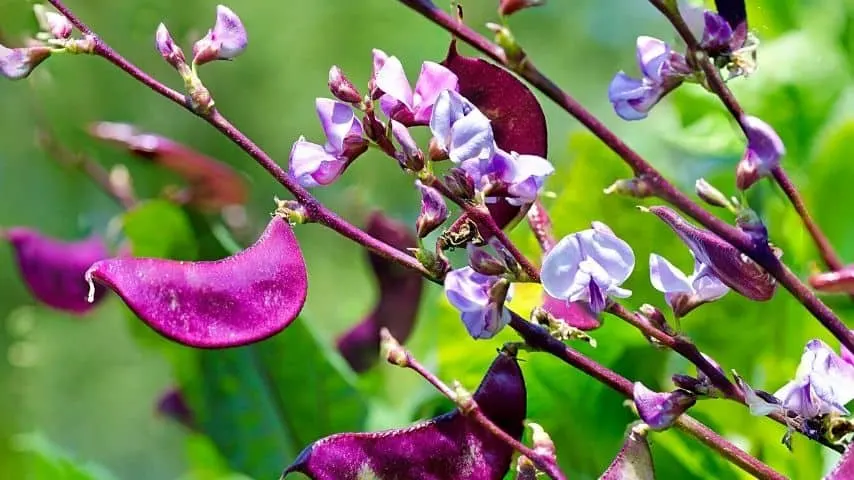
With the Hyacinth Bean’ pinkish-purple flowers and reddish-purple pods, you’ll expect a splash of color on your fence line
It is a beautiful, vigorous vine with pinkish-purple flowers and reddish-purple pods.
- Scientific name: Lablab purpureus
- Family: Fabaceae
- Temperature: between 65 and 75°F (18-23°C)
- Fertilizer: organic compost or a slow-release fertilizer
- pH: 4.5 to 7.5
- Soil: Loamy Soil
- Lighting: Full sun and direct sunlight.
- Growth rate: 12 to 15 feet in a season.
- Humidity: 30 to 33%
28. Hops
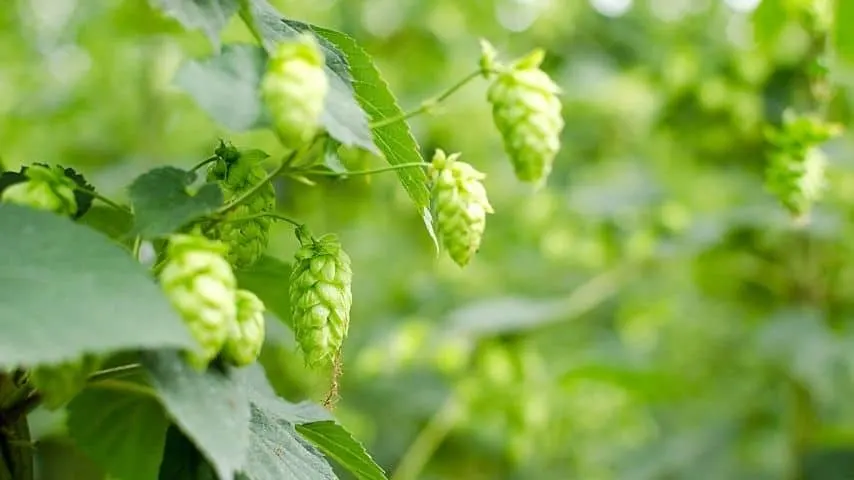
Hops is another attractive climbing vine that can cover your fence line with its dense foliage
It is an attractive climbing vine that helps cover fence lines by providing dense foliage and superb privacy.
- Scientific name: Humulus lupulus
- Family: Cannabaceae
- Temperature: 62 to 71 °F (17–22 °C)
- Fertilizer: late spring to early summer in the form of commercial fertilizer, organic matter, or manure
- pH: 4.5 to 8.2
- Soil: Deep, sandy loam
- Lighting: Full sun
- Growth rate: A foot or more a day under ideal conditions.
- Humidity: minimal exposure to moisture.
29. Mandevilla
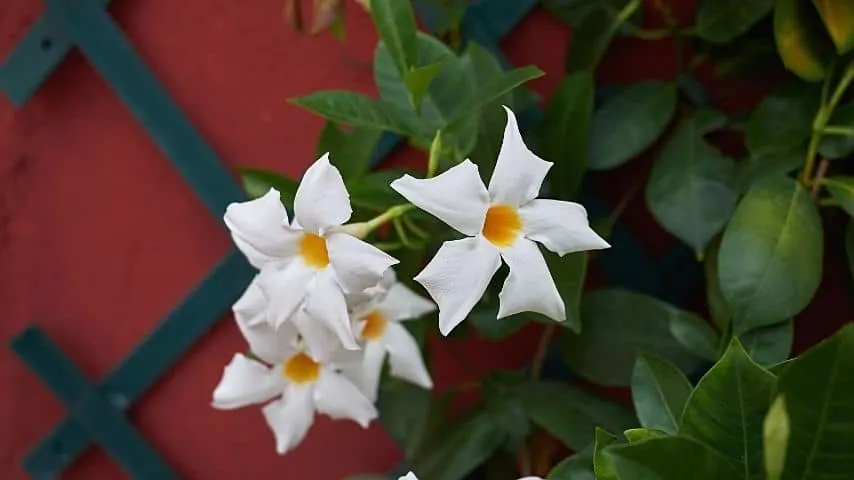
Mandevilla adds to the list of colorful climbing plants for your fence line
Mandevilla is a flowering vine that grows in tropical and subtropical climates. Its blooms throughout the summer and adds color to the fence line because of its red, pink, and white flowers.
- Scientific name: Mandevilla
- Family: Apocynaceae
- Temperature: 60 to 70 °F (14-21 °C).
- Fertilizer: Organic fertilizer every 2 to 3 weeks in the flowering season.
- pH: 6.6 to 7.8
- Soil: well-draining, sandy soil with organic material mixed in it
- Lighting: Full sun
- Growth rate: Up to 10 feet in a single season.
- Humidity: 50% and above.
30. Moonflower Vine
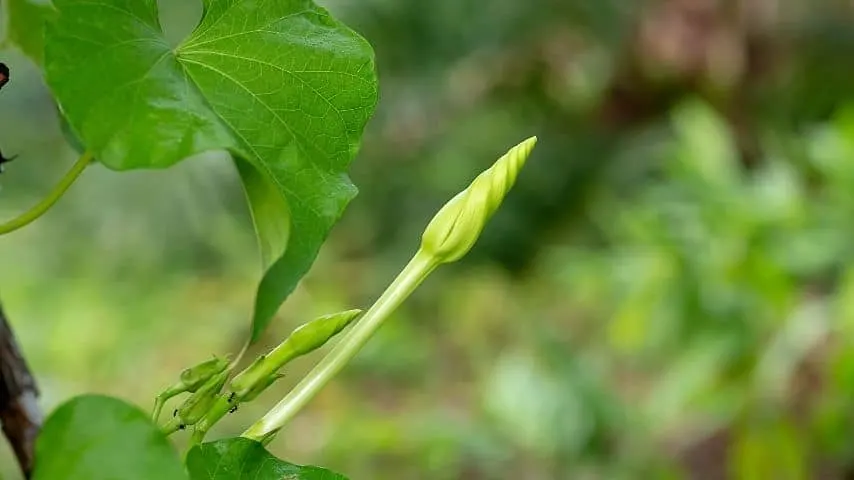
Moonflower Vine caps the list of beautiful plants that you can grow for your fence line
It is a scented flowering vine with large white flowers and heart-shaped leaves that add to the fence line’s beauty.
- Scientific name: Ipomoea alba
- Family: Convolvulaceae
- Temperature: Around 60 to 70 °F (14-21 °C)
- Fertilizer: Don’t have to fertilize
- pH: 6.0 to 7.5
- Soil: Loose, well-drained soil.
- Lighting: Full sun
- Growth rate: can reach 10-20 feet in length when grown in optimal conditions in one season
- Humidity: Grows best in warm and humid zones.
With such various choices, finding plants to grow for your fence line should not be difficult.

Daniel has been a plant enthusiast for over 20 years. He owns hundreds of houseplants and prepares for the chili growing seasons yearly with great anticipation. His favorite plants are plant species in the Araceae family, such as Monstera, Philodendron, and Anthurium. He also loves gardening and is growing hot peppers, tomatoes, and many more vegetables.

![30 Best Plants for Fence Line — Best List [2024]](https://plantophiles.com/wp-content/uploads/2022/04/30-Best-Plants-for-Fence-Line-720x405.jpg.webp)
